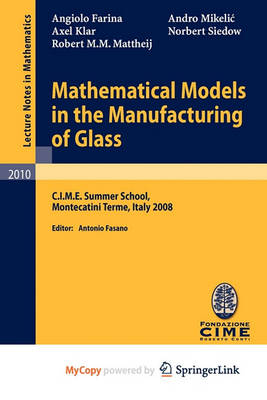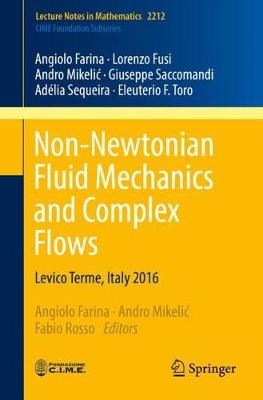Lecture Notes in Mathematics
3 primary works
Book 2010
Mathematical Models in the Manufacturing of Glass
by Angiolo Farina, Axel Klar, and Robert M M Mattheij
Published 8 December 2010
This volume presents a review of advanced technological problems in the glass industry and of the mathematics involved. It is amazing that such a seemingly small research area is extremely rich and calls for an impressively large variety of mathematical methods, including numerical simulations of considerable complexity. The problems treated here are very typical of the field of glass manufacturing and cover a large spectrum of complementary subjects: injection molding by various techniques, radiative heat transfer in glass, nonisothermal flows and fibre spinning. The book can certainly be useful not only to applied mathematicians, but also to physicists and engineers, who can find in it an overview of the most advanced models and methods.
Book 2062
Modelling and Optimisation of Flows on Networks
by Luigi Ambrosio, Alberto Bressan, Dirk Helbing, Axel Klar, and Enrique Zuazua
Published 14 December 2012
In recent years flows in networks have attracted the interest of many researchers from different areas, e.g. applied mathematicians, engineers, physicists, economists. The main reason for this ubiquity is the wide and diverse range of applications, such as vehicular traffic, supply chains, blood flow, irrigation channels, data networks and others.
This book presents an extensive set of notes by world leaders on the main mathematical techniques used to address such problems, together with investigations into specific applications. The main focus is on partial differential equations in networks, but ordinary differential equations and optimal transport are also included. Moreover, the modeling is completed by analysis, numerics, control and optimization of flows in networks.
The book will be a valuable resource for every researcher or student interested in the subject.
This book presents an extensive set of notes by world leaders on the main mathematical techniques used to address such problems, together with investigations into specific applications. The main focus is on partial differential equations in networks, but ordinary differential equations and optimal transport are also included. Moreover, the modeling is completed by analysis, numerics, control and optimization of flows in networks.
The book will be a valuable resource for every researcher or student interested in the subject.
Book 2212
Non-Newtonian Fluid Mechanics and Complex Flows
by Angiolo Farina, Lorenzo Fusi, Andro Mikelic, Giuseppe Saccomandi, Adelia Sequeira, and Eleuterio F. Toro
Published 26 June 2018
This book presents a series of challenging mathematical problems which arise in the modeling of Non-Newtonian fluid dynamics. It focuses in particular on the mathematical and physical modeling of a variety of contemporary problems, and provides some results. The flow properties of Non-Newtonian fluids differ in many ways from those of Newtonian fluids. Many biological fluids (blood, for instance) exhibit a non-Newtonian behavior, as do many naturally occurring or technologically relevant fluids such as molten polymers, oil, mud, lava, salt solutions, paint, and so on. The term "complex flows" usually refers to those fluids presenting an "internal structure" (fluid mixtures, solutions, multiphase flows, and so on). Modern research on complex flows has increased considerably in recent years due to the many biological and industrial applications.


